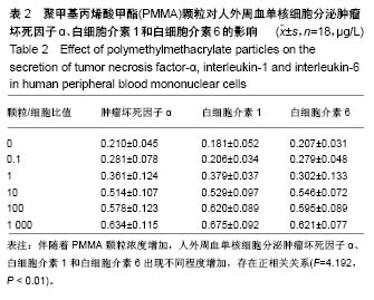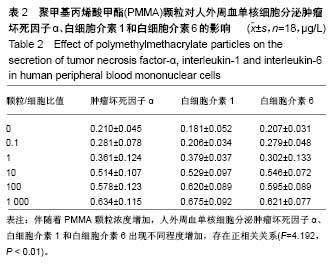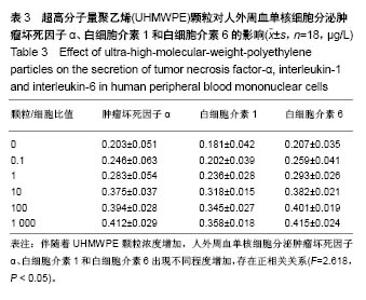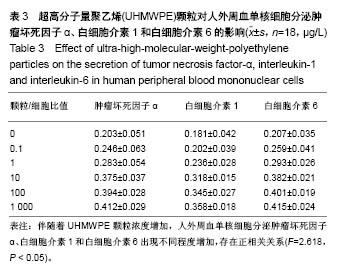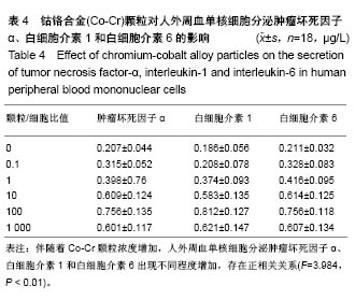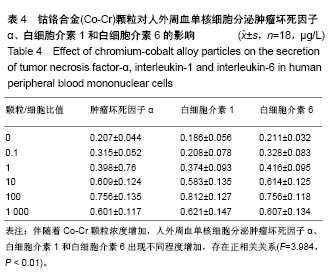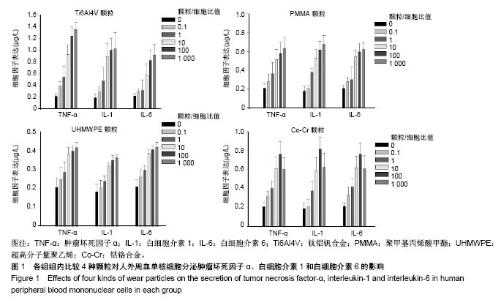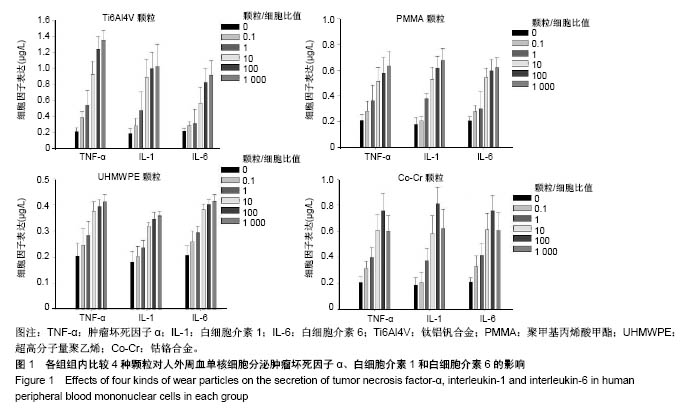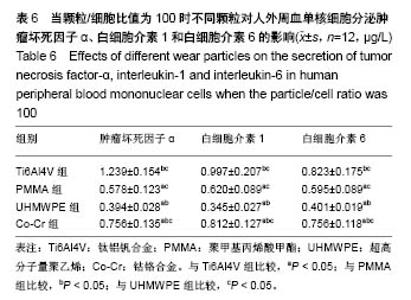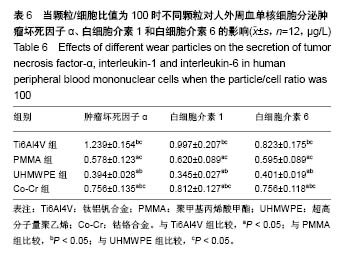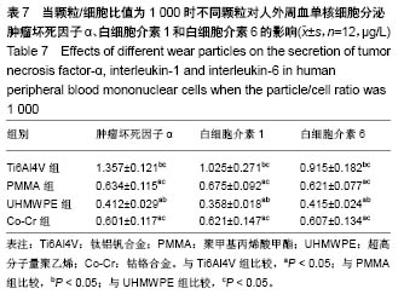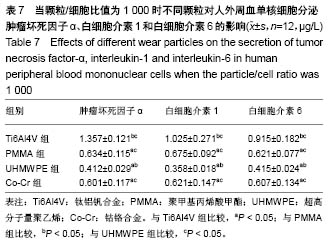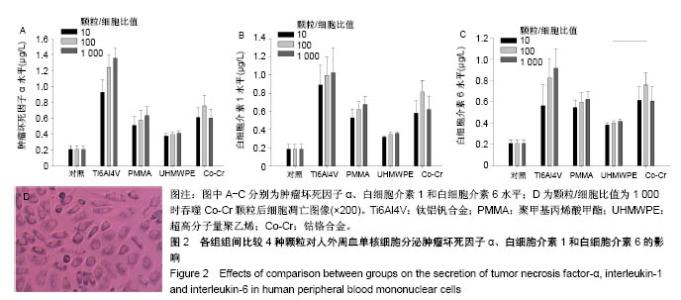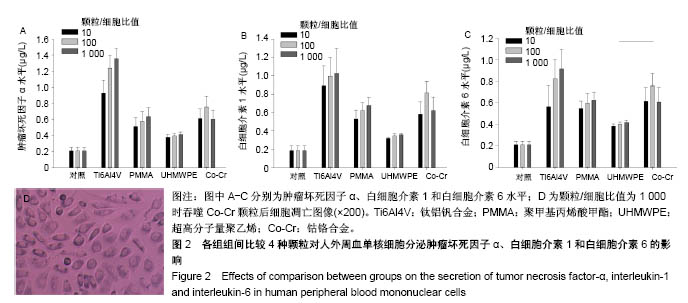Chinese Journal of Tissue Engineering Research ›› 2019, Vol. 23 ›› Issue (6): 894-900.doi: 10.3969/j.issn.2095-4344.1572
Previous Articles Next Articles
Influence of different wear particles on human peripheral blood mononuclear cells in vitro
Li Peng, Yang Shuye, Zhang Kai, Jia Long, Du Gangqiang, Liu Dong, Zhang Xinjun, Zhang Degang, Wang Zhigang
- Department of Trauma Orthopedics, Binzhou Medical University Hospital, Binzhou 256600, Shandong Province, China
-
Received:2018-10-26Online:2019-02-28Published:2019-02-28 -
Contact:Zhang Kai, MD, Chief physician, Master’s supervisor, Department of Trauma Orthopedics, Binzhou Medical University Hospital, Binzhou 256600, Shandong Province, China -
About author:Li Peng, Master, Physician, Department of Trauma Orthopedics, Binzhou Medical University Hospital, Binzhou 256600, Shandong Province, China -
Supported by:the National Natural Science Foundation of China, No. 81241061 (to ZK); Shandong Provincial Medical and Health Technology Development Project, No. 2016WS0023 (to YSY)
CLC Number:
Cite this article
Li Peng, Yang Shuye, Zhang Kai, Jia Long, Du Gangqiang, Liu Dong, Zhang Xinjun, Zhang Degang, Wang Zhigang. Influence of different wear particles on human peripheral blood mononuclear cells in vitro[J]. Chinese Journal of Tissue Engineering Research, 2019, 23(6): 894-900.
share this article
Add to citation manager EndNote|Reference Manager|ProCite|BibTeX|RefWorks
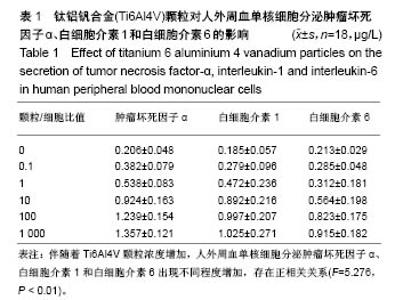
2.1 外周血单核细胞存活率 人外周血单核细胞与Ti6Al4V、PMMA、UHMWPE和Co-Cr颗粒不同浓度混悬液共培养时存活率均大于95%,仅有Co-Cr组颗粒/细胞比值为1 000时外周血单核细胞的存活率降至87%,证实Ti6Al4V、PMMA、UHMWPE和Co-Cr颗粒均可激活外周血单核细胞,促使其分泌不同水平的肿瘤坏死因子α、白细胞介素1和白细胞介素6等骨溶解相关细胞因子。 2.2 各组外周血单核细胞中肿瘤坏死因子α、白细胞介素1和白细胞介素6的水平 各组内比较结果显示Ti6Al4V组、PMMA组和UHMWPE组中伴随颗粒浓度的增加,人外周血单核细胞分泌肿瘤坏死因子α、白细胞介素1和白细胞介素6会出现不同程度的增强,存在正相关关系;但是Co-Cr组中当颗粒/细胞比值达到1 000时却出现肿瘤坏死因子α、白细胞介素1和白细胞介素6表达水平降低,见表1-4和图1。 "
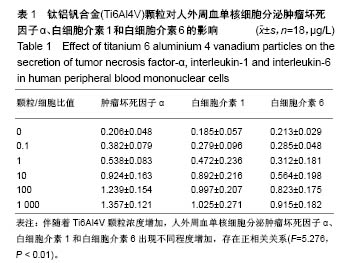
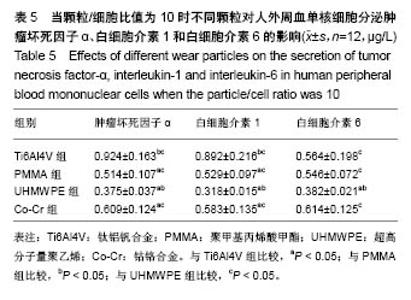
当颗粒/细胞比值10,100或1 000时,活化的单核细胞分泌肿瘤坏死因子α、白细胞介素1和白细胞介素6的水平与原始幼稚的单核细胞(颗粒/细胞比值为0时)相比,差异有显著性意义(P < 0.05)。 当颗粒/细胞比值为10时,PMMA组和Co-Cr组中肿瘤坏死因子α和白细胞介素1表达水平均明显低于Ti6Al4V组,但是均高于UHMWPE组;除了PMMA组与Co-Cr组相比较外,其余各组之间肿瘤坏死因子α和白细胞介素1表达水平差异均有显著性意义(P < 0.05)。Ti6Al4V组、PMMA组和Co-Cr组中白细胞介素6表达水平均高于UHMWPE组,差异均有显著性意义(P < 0.05);Ti6Al4V组、PMMA组和Co-Cr组中任意两组相比较,白细胞介素6表达水平差异无显著性意义(P > 0.05)。 当颗粒/细胞比值为100时,Co-Cr组中肿瘤坏死因子α、白细胞介素1和白细胞介素6表达水平均明显低于Ti6Al4V组,PMMA组中肿瘤坏死因子α、白细胞介素1和白细胞介素6表达水平均低于Co-Cr组,但仍高于UHMWPE组。各组肿瘤坏死因子α、白细胞介素1和白细胞介素6表达水平相比较,差异均有显著性意义(P < 0.05)。 当颗粒/细胞比值为1 000时,PMMA组和Co-Cr组中肿瘤坏死因子α、白细胞介素1和白细胞介素6表达水平均明显低于Ti6Al4V组,但是均高于UHMWPE组;除了PMMA组和Co-Cr组相比较外,其余各组间肿瘤坏死因子α、白细胞介素1和白细胞介素6表达水平差异均有显著性意义(P < 0.05)。 总体来讲,在骨溶解反应的初始阶段中Ti6Al4V颗粒的功能生物学活性最强,其次是Co-Cr和PMMA颗粒,UHMWPE颗粒最弱,见表5-7和图2。"
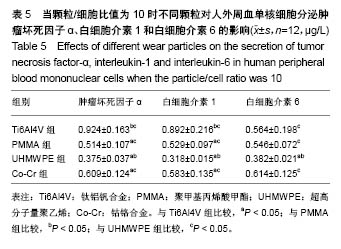
| [1] Learmonth ID, Young C, Rorabeck C. The operation of the century: total hip replacement. Lancet. 2007;370(9597):S1508-1519.[2] Del Buono A, Denaro V, Maffulli N. Genetic susceptibility to aseptic loosening following total hip arthroplasty: a systematic review. Br Med Bull. 2012;101:39-55.[3] Gudena R, Kuna S, Pradhan N. Aseptic loosening of total hip replacement presenting as an anterior thigh mass. Musculoskelet Surg. 2013;97(3):247-249.[4] Landgraeber S, Wegner A, Canbay A, et al. Serum levels of adiponectin in patients with aseptic loosening after total hip replacement. J Biomed Mater Res A. 2010;93(2):748-752.[5] Ollivere B, Darrah C, Brankin RC, et al. The continued value of clinical and radiological surveillance: the Charnley Elite Plus hip replacement system at 12 years. J Bone Joint Surg Br. 2009;91(6): 720-724.[6] Bozic KJ, Kurtz SM, Lau E, et al. The epidemiology of revision total hip arthroplasty in the United States. J Bone Joint Surg Am. 2009;91(1): 128-133.[7] Jiang Y, Jia T, Wooley PH, et al. Current research in the pathogenesis of aseptic implant loosening associated with particulate wear debris. Acta Orthop Belg. 2013;79(1):1-9.[8] Jiang Y, Jia T, Gong W, et al. Effects of Ti, PMMA, UHMWPE, and Co-Cr wear particles on differentiation and functions of bone marrow stromal cells. J Biomed Mater Res A. 2013;101(10): 2817-2825.[9] Ingham E, Fisher J. Biological reactions to wear debris in total joint replacement. Proc Inst Mech Eng H. 2000;214(1):21-37.[10] Zhang K, Yang SY, Yang S, et al. Different influence of Ti, PMMA, UHMWPE, and Co-Cr particles on peripheral blood monocytes during periprosthetic inflammation. J Biomed Mater Res A. 2015 103(1):358-364.[11] Lin TH, Tamaki Y, Pajarinen J, et al. Chronic inflammation in biomaterial-induced periprosthetic osteolysis: NF-κB as a therapeutic target. Acta Biomater. 2014;10(1):1-10.[12] Catelas I, Jacobs JJ. Biologic activity of wear particles. Instr Course Lect. 2010;59:3-16.[13] Lübbeke A, Garavaglia G, Barea C, et al. Influence of patient activity on femoral osteolysis at five and ten years following hybrid total hip replacement. J Bone Joint Surg Br. 2011;93(4):456-463.[14] Chiba J, Rubash HE, Kim KJ, et al. The characterization of cytokines in the interface tissue obtained from failed cementless total hip arthroplasty with and without femoral osteolysis. Clin Orthop Relat Res. 1994;(300):304-312.[15] Shanbhag AS, Kaufman AM, Agarwal S, et al. Critical insights into osteolysis using protein microarrays: The importance of IL-6 and T-cell Activation. Trans Orthop Res Soc. 2005; 30:148.[16] Kaufman AM, Alabre CI, Rubash HE, et al. Human macrophage response to UHMWPE, TiAlV, CoCr, and alumina particles: analysis of multiple cytokines using protein arrays. J Biomed Mater Res A. 2008;84(2):464-474.[17] Atkins GJ, Haynes DR, Howie DW, et al. Role of polyethylene particles in peri-prosthetic osteolysis: A review. World J Orthop. 2011;2(10):93-101.[18] Matthews JB, Besong AA, Green TR, et al. Evaluation of the response of primary human peripheral blood mononuclear phagocytes to challenge with in vitro generated clinically relevant UHMWPE particles of known size and dose. J Biomed Mater Res. 2000;52(2):296-307.[19] Shanbhag AS, Jacobs JJ, Black J, et al. Human monocyte response to particulate biomaterials generated in vivo and in vitro. J Orthop Res. 1995;13(5):792-801.[20] Shanbhag AS, Jacobs JJ, Black J, et al. Effects of particles on fibroblast proliferation and bone resorption in vitro. Clin Orthop Relat Res. 1997; (342):205-217.[21] Haynes DR, Rogers SD, Hay S, et al. The differences in toxicity and release of bone-resorbing mediators induced by titanium and cobalt- chromium-alloy wear particles.J Bone Joint Surg Am.1993;75(6): 825-834.[22] Sethi RK, Neavyn MJ, Rubash HE, et al. Macrophage response to cross-linked and conventional UHMWPE. Biomaterials. 2003; 24(15):2561-2573.[23] Yamanaka Y, Karuppaiah K, Abu-Amer Y. Polyubiquitination events mediate polymethylmethacrylate (PMMA) particle activation of NF-kappaB pathway. J Biol Chem. 2011;286(27):23735-23741.[24] González O, Smith RL, Goodman SB. Effect of size, concentration, surface area, and volume of polymethylmethacrylate particles on human macrophages in vitro. J Biomed Mater Res.1996;30(4): 463-473.[25] Sabbatini M, Piffanelli V, Boccafoschi F, et al. Different apoptosis modalities in periprosthetic membranes. J Biomed Mater Res A. 2010;92(1):175-184.[26] Catelas I, Petit A, Zukor DJ, et al. TNF-alpha secretion and macrophage mortality induced by cobalt and chromium ions in vitro-qualitative analysis of apoptosis. Biomaterials. 2003; 24(3): 383-391.[27] Schalock PC, Menné T, Johansen JD, et al. Hypersensitivity reactions to metallic implants - diagnostic algorithm and suggested patch test series for clinical use. Contact Dermatitis. 2012;66(1):4-19.[28] Tsaousi A, Jones E, Case CP. The in vitro genotoxicity of orthopaedic ceramic (Al2O3) and metal (CoCr alloy) particles. Mutat Res. 2010; 697(1-2):1-9.[29] VanOs R, Lildhar LL, Lehoux EA, et al. In vitro macrophage response to nanometer-size chromium oxide particles. J Biomed Mater Res B Appl Biomater. 2014;102(1):149-159. |
| [1] | Zhang Tongtong, Wang Zhonghua, Wen Jie, Song Yuxin, Liu Lin. Application of three-dimensional printing model in surgical resection and reconstruction of cervical tumor [J]. Chinese Journal of Tissue Engineering Research, 2021, 25(9): 1335-1339. |
| [2] | Zeng Yanhua, Hao Yanlei. In vitro culture and purification of Schwann cells: a systematic review [J]. Chinese Journal of Tissue Engineering Research, 2021, 25(7): 1135-1141. |
| [3] | Xu Dongzi, Zhang Ting, Ouyang Zhaolian. The global competitive situation of cardiac tissue engineering based on patent analysis [J]. Chinese Journal of Tissue Engineering Research, 2021, 25(5): 807-812. |
| [4] | Wu Zijian, Hu Zhaoduan, Xie Youqiong, Wang Feng, Li Jia, Li Bocun, Cai Guowei, Peng Rui. Three-dimensional printing technology and bone tissue engineering research: literature metrology and visual analysis of research hotspots [J]. Chinese Journal of Tissue Engineering Research, 2021, 25(4): 564-569. |
| [5] | Chang Wenliao, Zhao Jie, Sun Xiaoliang, Wang Kun, Wu Guofeng, Zhou Jian, Li Shuxiang, Sun Han. Material selection, theoretical design and biomimetic function of artificial periosteum [J]. Chinese Journal of Tissue Engineering Research, 2021, 25(4): 600-606. |
| [6] | Liu Fei, Cui Yutao, Liu He. Advantages and problems of local antibiotic delivery system in the treatment of osteomyelitis [J]. Chinese Journal of Tissue Engineering Research, 2021, 25(4): 614-620. |
| [7] | Li Xiaozhuang, Duan Hao, Wang Weizhou, Tang Zhihong, Wang Yanghao, He Fei. Application of bone tissue engineering materials in the treatment of bone defect diseases in vivo [J]. Chinese Journal of Tissue Engineering Research, 2021, 25(4): 626-631. |
| [8] | Zhang Zhenkun, Li Zhe, Li Ya, Wang Yingying, Wang Yaping, Zhou Xinkui, Ma Shanshan, Guan Fangxia. Application of alginate based hydrogels/dressings in wound healing: sustained, dynamic and sequential release [J]. Chinese Journal of Tissue Engineering Research, 2021, 25(4): 638-643. |
| [9] | Chen Jiana, Qiu Yanling, Nie Minhai, Liu Xuqian. Tissue engineering scaffolds in repairing oral and maxillofacial soft tissue defects [J]. Chinese Journal of Tissue Engineering Research, 2021, 25(4): 644-650. |
| [10] | Xing Hao, Zhang Yonghong, Wang Dong. Advantages and disadvantages of repairing large-segment bone defect [J]. Chinese Journal of Tissue Engineering Research, 2021, 25(3): 426-430. |
| [11] | Sun Jianwei, Yang Xinming, Zhang Ying. Effect of montelukast combined with bone marrow mesenchymal stem cell transplantation on spinal cord injury in rat models [J]. Chinese Journal of Tissue Engineering Research, 2021, 25(25): 3962-3969. |
| [12] | Wang Hao, Chen Mingxue, Li Junkang, Luo Xujiang, Peng Liqing, Li Huo, Huang Bo, Tian Guangzhao, Liu Shuyun, Sui Xiang, Huang Jingxiang, Guo Quanyi, Lu Xiaobo. Decellularized porcine skin matrix for tissue-engineered meniscus scaffold [J]. Chinese Journal of Tissue Engineering Research, 2021, 25(22): 3473-3478. |
| [13] | Mo Jianling, He Shaoru, Feng Bowen, Jian Minqiao, Zhang Xiaohui, Liu Caisheng, Liang Yijing, Liu Yumei, Chen Liang, Zhou Haiyu, Liu Yanhui. Forming prevascularized cell sheets and the expression of angiogenesis-related factors [J]. Chinese Journal of Tissue Engineering Research, 2021, 25(22): 3479-3486. |
| [14] | Liu Chang, Li Datong, Liu Yuan, Kong Lingbo, Guo Rui, Yang Lixue, Hao Dingjun, He Baorong. Poor efficacy after vertebral augmentation surgery of acute symptomatic thoracolumbar osteoporotic compression fracture: relationship with bone cement, bone mineral density, and adjacent fractures [J]. Chinese Journal of Tissue Engineering Research, 2021, 25(22): 3510-3516. |
| [15] | Liu Liyong, Zhou Lei. Research and development status and development trend of hydrogel in tissue engineering based on patent information [J]. Chinese Journal of Tissue Engineering Research, 2021, 25(22): 3527-3533. |
| Viewed | ||||||
|
Full text |
|
|||||
|
Abstract |
|
|||||
